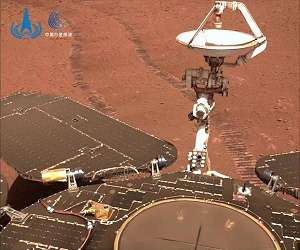A team of scientists, including Dr. German Martinez from the Universities Space Research Association at LPI, just published a study in the Proceedings of the National Academy of Sciences. This study indicates there are seasonal energy imbalances in the amount of solar energy absorbed and released by Mars which is a likely cause of dust storms, and could play an important role in understanding the climate and atmosphere of the red planet.
The radiant energy budget (a term referring to the measurement of solar energy a planet takes in from the sun then releases as heat) of a planet is a fundamental metric. Based on observations from multiple missions, a team of scientists provided a global picture of Mars’ climate. Measurements from the NASA’s Mars Global Surveyor, Mars Science Laboratory’s Curiosity rover, and InSight missions reveal strong seasonal and diurnal variations of Mars’ emitted power.
“One of the most interesting findings is that energy excess-more energy being absorbed than produced-could be one of the generating mechanisms of dust storms on Mars,” says Ellen Creecy, the lead author of the study1 and a doctoral student from the University of Houston, Texas.
“Our results showing strong energy imbalances suggest that current numerical models should be revisited, as these typically assume that Mars’ radiant energy is balanced between Mars’ seasons,” said Dr. German Martinez, USRA Staff Scientist at the Lunar and Planetary Institute (LPI) and co-author of the paper. “Furthermore, our results highlight the connection between dust storms and energy imbalances, and thus can provide new insights into the generation of dust storms on Mars.”
In this study, a team of scientists used observations from martian satellites, landers, and rovers to estimate Mars’ emitted energy globally as a function of season, including periods with a global dust storm. They found that there is a strong energy imbalance of ~15.3 % between Mars’ seasons, which is much larger than on Earth (0.4%) or Titan (2.9%). They also found that during the 2001 planet-encircling dust storm on Mars, the global-average emitted power decreased by 22% during daytime but increased by 29% during nighttime.
The results of this study, in combination with numerical models, have the potential to improve the current understanding of the martian climate and atmospheric circulations, which is important for the future human exploration of Mars and could perhaps foretell Earth’s own climate issues.
Research Report:Mars’ emitted energy and seasonal energy imbalance
Related Links
Universities Space Research Association
Mars News and Information at MarsDaily.com
Lunar Dreams and more
|
We need your help. The SpaceDaily news network continues to grow but revenues have never been harder to maintain. With the rise of Ad Blockers, and Facebook – our traditional revenue sources via quality network advertising continues to decline. And unlike so many other news sites, we don’t have a paywall – with those annoying usernames and passwords. Our news coverage takes time and effort to publish 365 days a year. If you find our news sites informative and useful then please consider becoming a regular supporter or for now make a one off contribution. |
||
|
SpaceDaily Contributor $5 Billed Once credit card or paypal |
SpaceDaily Monthly Supporter $5 Billed Monthly paypal only |
|

![]()
China releases images of Martian dust taken by Tianwen-1 orbiter
Beijing (XNA) Mar 25, 2022
China’s Tianwen-1 orbiter has beamed back high-resolution images of Mars, showing dust storms on the surface of the planet.
Released by the China National Space Administration on Thursday, the new pictures with a resolution of 0.5 meters were captured by a camera on the probe, which has been operating in orbit for 609 days at a distance of 277 million km from Earth.
Track marks left by Mars rover Zhurong can be seen in the pictures. With its 306 Martian days of service, the rover has travele … read more